ESPN
January 20, 2013
Back in the late winter of 1941, a skinny, 20-year-old pitcher named Stan Musial showed up at the St. Louis Cardinals' spring training camp with an aching arm and diminishing hopes that he would ever fulfill his youthful dream of making it to the big leagues.
Musial, who died Saturday at the age of 92, had come up as an erratic, wild-throwing southpaw -- so wild, in fact, that a scouting report at one point urged his release -- in the Cards' minor league system in 1938. His prospects grew only darker in August 1940 in Orlando, Fla., when he was chasing a fly ball in the outfield and his cleats got caught in the turf. He fell hard on the point of his left shoulder, the one to which his pitching arm was attached. With his shoulder injured, he lost the pop on his fastball, and Cardinals hitters began teeing off on him. He later remembered throwing one pitch to his boyhood idol, Cards star center fielder Terry Moore, and then hearing the crack of the bat and watching the ball carry out of the park.
Discouraged as he was, the young man did not quit. As fate would have it, on a day Cards legendary general manager Branch Rickey was watching an intrasquad game in Hollywood, Fla., Musial himself hit a ponderous home run over the right-field fence. This turned out to be, for the Cards as a team and baseball in general, a wonderfully propitious moment. Musial's arm never did completely heal; but at the end of camp, when Rickey heard some sentiment among coaches to send the kid packing, he waved those voices away.
[+] Enlarge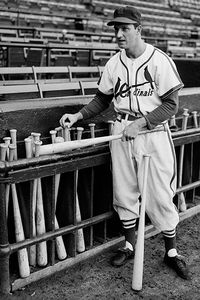

AP PhotoWhen Musial chose his weapon, pitchers always found themselves in harm's way.
So when Rickey heard talk that sore-armed Stanley ought to be released, he ordered the kid sent to the Cards' Class C affiliate in Springfield, Mo.
"Don't let him go," the Mahatma said. "Put him in the outfield and see if he can hit."
This was, as things turned out, a declaration worthy of enshrinement in the National Baseball Hall of Fame, right next to the plaque honoring Musial himself. Indeed, over the next two decades, his physical presence in the batter's box left a lasting impression on all who saw him stroke a baseball with a wooden bat.
His stance was singular. Musial stood slightly crouched -- "I started to crouch because that way I could guard the plate better," he once said -- with his bat straight up, his feet close together and his shoulders turned so far to the left that the pitcher, Lord help him, could read the "6" on Musial's back. He had learned as a kid how to go with a pitch and how to slap the ball to left field, a talent that gave him an enormous edge and, as can be imagined, drove opposing fielders to distraction unto despair. Managers forever were flummoxed as to how to defend against him. Early in the season of 1951, not long after 20-year-old Willie Mays first was called up to the New York Giants, manager Leo Durocher met with the young slugger to go over the opposing hitters for that day. The Giants were playing the St. Louis Cardinals, and Durocher briefed Mays on the Cards' lineup, telling Mays how to play the first hitter, then the second hitter and then the fourth hitter.
"What about number three?" Mays asked.
"The third hitter is Stan Musial," Durocher told him. "There is no advice I can give you about him."
What complicated things for Durocher and fellow skippers was the fact that Musial was fast on his feet. Stretching singles into doubles or doubles into triples, he could hit another gear on the basepaths, prompting one manager to liken Musial at full gallop to "a wounded turkey." They nicknamed him the "Donora Greyhound," a reference to his hometown in Pennsylvania.
Blessed with such an array of talents, Musial became not only one of the dozen or so greatest hitters in the annals of baseball, but he also was clearly the finest left-handed batter who ever graced a box in the National League. In the course of his surpassing career, he hung up such prodigious numbers that James, the eminent guru and muncher of baseball stats, ranked him at the end of the 20th century as the 10th greatest player of all time.
[+] Enlarge

AP PhotoAfter a stint in the Navy, Musial returned to the Cardinals in 1946 -- he's at spring training here -- and hit .365.
Musial retired at the end of the 1963 season, but nearly a half-century later, he still is second in total bases with 6,134, behind Aaron (6,856) and just ahead of Mays (6,066). No active ballplayer is even close, and Musial left the game well ahead of Cobb, Ruth, Pete Rose and Carl Yastrzemski.
In the realm of all-time leaders, Musial is fourth in hits with 3,630, sixth in RBIs with 1,951, ninth in runs scored with 1,949, third in extra-base hits with 1,377, third in doubles with 725 and tied for 19th (with Rabbit Maranville) in triples, although again, it is only fair to point out that 10 of those ahead of him in three-baggers began their careers when triples were as plentiful as buffalo, and no less endangered, in the years immediately following Custer's Last Stand.
His ratio of at-bats to strikeouts also is among the best in the history of the majors. Here is one you would not have guessed: Musial had 3,266 more at-bats than Williams but 13 fewer strikeouts (696 for Musial, 709 for Williams), and Williams owned a pair of the most famously discriminating batting eyes in the game. And while Musial ranks 28th in home runs, tied with Willie Stargell at 475, his true place in that pantheon is difficult to fathom in the wake of the recent orgies of chemical enhancement.
All that said, the combined weights of the Musial numbers bear James out, and they certainly give powerful affirmation to those many voices along the Mississippi Valley that have been crying for years that Stan was The Man. So it always has been something of a mystery why Musial -- as generous and decent a man off the field as he was brilliant and dependable on it -- has spent so many years sunk in the shadows of baseball history, a giant often either forgotten or dismissed whenever the sports-talk junkies summon the names of baseball's finest hitters and all-around players.
[+] Enlarge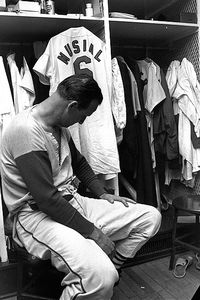

AP PhotoEnd of an era: Musial went 2-for-3 in his final game on Sept. 29, 1963, and then waited for his teammates in the Cardinals' clubhouse.
No doubt these embarrassing instances of poor judgment can be traced, at least in part, to the town Musial called home. He played baseball out of St. Louis, not New York, and he did so mostly in an era when that burg was as far west as baseball reached, on the near edge of the American wilderness known as the Great Plains. No one wrote songs about him. No one penned lyrics invoking his name. No character in a Hemingway novel ever mused about him. And no one made a movie of his life. He often visited the media capital of America, but he never was a creation or a creature of it.
Musial had neither the flair nor the flamboyance of Willie Mays.
No basket catches by Stanley.
He did not crush 500-foot home runs over the white walls of the Bronx, recalling the titanic shots of Babe Ruth and Jimmie Foxx.
[+] Enlarge

AP Photo/Tom GannamWho better than Musial to throw out the ceremonial first pitch before a Cardinals division playoff series game in 2004?
Nor did Stanley have Mickey Mantle's awesome speed and ambidextrous power.
He never got into a single drunken brawl at the Copacabana.
In fact, through the 3,026 games he played in his career, he never got kicked out of one. Not a single game. Ken Burkhart umpired scores of St. Louis games behind the plate and said Musial never once complained to him about one of his calls, not even one of those hair-splitting called strikes that might have gone either way.
"In seven years, he never even turned his head to look at me when I was behind the plate," Burkhart said.
Nor did he marry the blond movie star with the dress billowing above the subway vent, and he never insisted on being introduced at old-timers' games as "the greatest living ballplayer," although you could make a far stronger case for him than you could for Joe D.
No, Musial married the grocer's daughter from Donora, a shot-and-a-beer mill town that lay some 28 miles south of Pittsburgh, on the banks of the Monongahela River. He grew up, one of a family of eight, in a five-room, wood-frame house at the top of a hill. His father, Lukasz, a Polish immigrant, worked in a zinc factory. A hanging blanket of sulfurous fumes killed all the vegetation on the hill and eventually the old man, too. Lillian Labash, the grocer's daughter, first saw Musial in Palmer Park when he was a 14-year-old lad working as a bat boy for the team of zinc workers managed by a neighbor, Joe Barbao. That day, they were playing another team of blue collars from nearby Monessen. Barbao had run out of pitchers, according to the late sportswriter W.C. Heinz, so he threw young Musial into the fray. Musial pitched six innings and fanned 13 hitters.
"Look at that Polish kid pitch against those men," the grocer said to his daughter.
[+] Enlarge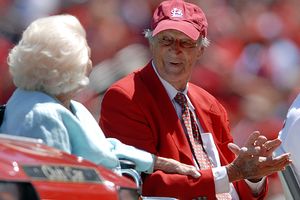

AP Photo/Kyle EricsonAt a day in his honor in May 2008, Stan and his wife, childhood sweetheart Lil, were feted by the Cardinals and their fans.
It did not take Rickey long to learn how right he had been about giving the kid a chance. At Springfield, in just 87 games, Musial hit 26 home runs and had a whopping 94 runs batted in -- a glorious harbinger of his baseball life. After having hit at an equally torrid clip with the Cards' Double-A Rochester club, Musial was home in Donora in mid-September 1941 when he got that unforgettable telegram. It was from Rickey, ordering him to report to the mother club.
"It was really something," Musial told Heinz. "Imagine a 20-year-old kid who starts the year pitching with a sore arm and can't tell if he's gonna make it anywhere in organized ball and ends up …"
… Stepping into the St. Louis clubhouse for the first time in his life and immediately running into Terry Moore, that outfielder who had been his boyhood idol.
Moore looked at him quizzically. "You look familiar," he said.
"I ought to," Musial said. "You hit a homer off me in an exhibition game this spring."
"Are you that humpty-dumpty, bum-armed kid?" Moore said. "How'd you get way up here?"
That was the question in the Cards' clubhouse that afternoon, and it took Musial no time at all to answer it. That day against the Boston Braves, in his first major league game, he found himself face to face with a knuckleballer, Jim Tobin. Musial had never seen a knuckler, and he sliced under the first one for a popup out. Tobin later tried to fool the rookie again, fluttering up another knuckler, but this time, Musial lashed it for a double to right, scoring two runs to help win the game 3-2.
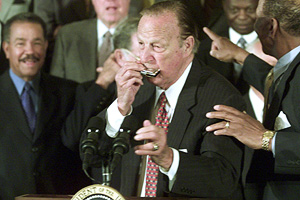
AP Photo/Ron EdmondsMusial was rarely without his harmonica, including at a White House ceremony honoring Hall of Famers in 2001. That's Ernie Banks, right, leading the cheers while Juan Marichal, left, and Lou Brock look on.
Leave it to Casey to call that shot, almost to the year. Rarely has baseball seen a more sustained display of excellence, consistency and class than in the 22 years Stanley Frank Musial played baseball. Beyond that brief debut in 1941, he hit no less than .310 for 16 consecutive seasons, a span during which his batting average was .340 and as high as .376 in 1948, his signature year: 230 hits, 46 doubles, 18 triples, 39 home runs, 135 runs, 131 RBIs. It was the year the Phillies' new manager, Eddie Sawyer, was asked what he thought of the National League teams.
"Of all the teams I've seen so far," Sawyer said, "Musial is the best."
It also was the year he won one of his seven batting titles and one of his three MVP awards. By then, he was so feared by pitchers that they began to joke about how they pitched to him.
The Brooklyn Dodgers' pinpoint control specialist, Preacher Roe, once said of Musial: "I throw four wide ones to him and then try to pick him off first."
"I've had pretty good success with Musial by throwing him my best pitch and backing up third," the Dodgers' Carl Erskine said.
As humble as he was, shy to a fault, Musial felt utterly at home between the chalk lines. No one had more confidence in him than he had in himself. In the 1955 All-Star Game, with the score knotted in the bottom of the 12th inning, Musial came to the plate and was greeted by a very tired Yogi Berra, who was catching that day.
"My feet are killing me," Yogi said to Musial.
"Relax," Musial said, "I'll have you home in a minute."
He homered into the seats, winning the game. In fact, the homer became one of a record six he hit for the National League in All-Star Games.
[+] Enlarge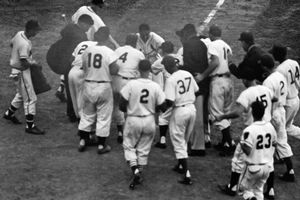

AP PhotoThis celebration of a Musial long ball ended the 1955 All-Star Game in the 12th inning and sent a tired Yogi Berra home.
And as often as he hurt the Dodgers, they never booed him in Brooklyn, where he became so inspired he seemed to enter a whole new zone as a hitter.
"There was always excitement in Brooklyn," Musial once said. "My adrenaline was always flowing in Ebbets Field. The tension, the atmosphere, the fights -- you knew something was going to happen. … The ballpark was small, so the seats were close to the field, and you could hear just about anything anybody said."
Musial heard plenty in those summers of 1948 and 1949, when he hit .522 in Ebbets Field and appeared, like "The Natural," able to do almost anything he wanted with the bat. It was where they coined his other nickname. "I'd come to the plate and the fans would say, 'Here comes that man again, that man.' A sportswriter picked it up and it became 'Stan the Man.'"
It also was the era when Jackie Robinson integrated baseball, and with Robinson's arrival, the game became rife with rumors that some players were planning to boycott any games involving the Dodgers. The hottest of these beds was St. Louis, where there were a number of Southern players. But Musial openly backed Robinson, and the Cards never voted to strike. Musial had played with and against blacks in high school, and among his teammates was Buddy Griffey -- later the father of Ken Griffey Sr. and the grandfather of Ken Griffey Jr. "I didn't give it a second thought," Musial said.
Indeed. When another black player, Joe Black, came up to play in Brooklyn five years later, in 1952, racial slurs still were being heard in baseball. In one game, with Black on the mound, Musial was in the box and set to hit when he heard one of his own teammates shout from the dugout, "Don't worry, Stan. With that dark background on the mound, you shouldn't have any trouble hitting the ball." After the game, Black was dressing in the Brooklyn clubhouse when Musial sidled up to him.
"I'm sorry that happened," Musial said quietly. "But don't you worry about it. You're a great pitcher. You'll win a lot of games."
[+] Enlarge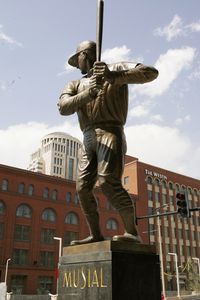

AP Photo/James FinleyBaseball fans will always have the statue of Musial outside Busch Stadium by which to remember him.
Musial always described himself as a retiring man who shied from public appearances, particularly if they involved giving speeches, but he was perfectly at home in social gatherings and loved to party. For years, he was the central schmoozer and greeter at his famous St. Louis restaurant, Stan Musial and Biggie's, serving as the city's informal host in the same way Jack Dempsey served New York from a table at his famous Times Square eatery. He was no shirking violet when it came to public celebrations. One day in 1986, in the week before the Bears-Patriots Super Bowl in New Orleans, a young sportswriter was sitting in a bar in the French Quarter when, suddenly, a conga line came dancing off the street and through the bar. It snaked past the table of the sportswriter, who thought he had to be seeing things through a beery mist. There was Musial, then 65 years old, dancing at the head of the line as he blew the throbbing conga tune from his harmonica.
By this time, of course, Musial long had been an institution in St. Louis -- not only as a Hall of Fame baseball player, but as a roving, sometimes dancing, ambassador for the Cards' franchise, his adopted city and the sport of professional baseball. He visited his father's native Poland several times since 1970, including once to meet with the Polish Olympic Committee, which was striving to build a ballclub that would be competitive on the international baseball stage, and another time to attend the dedication of two Little League fields named in his honor and to pass out 250 gloves to all those young, aspiring Musials in cities like Wroclaw and Jaslo. Musial stayed with the Cards long after his playing days were over and was the team's general manager when it won the 1967 World Series.
In many ways, Musial more than served the Cardinals. He was the franchise. A formidable statue of Musial was erected in front of Busch Stadium, and the inscription had it right: "Baseball's perfect warrior, baseball's perfect knight."
He was, and will always be, Stan the Man.
William Nack was a senior writer at Sports Illustrated for nearly 25 years and covered stories in a wide variety of sports and on a wide range of subjects. He is the author of three books:"Ruffian: A Racetrack Romance," "My Turf: Horses, Boxers, Blood-Money and the Sporting Life"and "Secretariat: The Making of a Champion."
